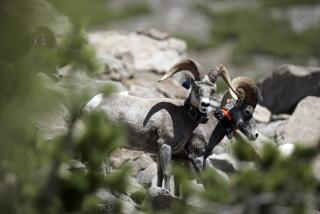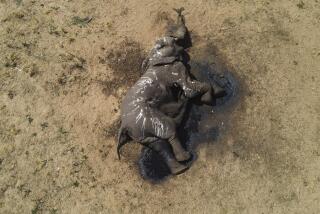COLUMN ONE : Africa’s Call of the Wild: Help! : As drought ravages southern nations, rangers struggle to rescue wild game and ranchers build modern-day Noah’s arks to save animals from extinction.
- Share via
PHALABORWA, South Africa — The trees across vast stretches of southern Africa have turned white with thirst. The grass has vanished, leaving bare earth. Dry riverbeds have cracked like brown checkerboards.
And tens of thousands of emaciated zebras and giraffes, antelopes and wildebeests rest silently in the hot shade, ignoring the rising stench of rotting animal carcasses.
Human beings will survive this drought, the worst in these parts in 60 years, and they will restore their decimated cattle herds one day. But now they are battling to save the rich wildlife heritage--one of the world’s few remaining havens for wild game--from devastation and extinction.
Game rangers from South Africa to Zimbabwe are using helicopters and trucks to rescue hundreds of giant hippopotamuses, rhinoceroses, elephants and buffalo from certain starvation, moving them to greener pastures and running rivers. Farmers are building modern-day Noah’s arks to shelter thousands more.
Buffalo are being fed intravenously on one South African game reserve. On another, crocodiles stranded in dry rivers are being airlifted to new and wet homes, where they will await the return of the rains.
And in Zimbabwe, trucks filled with soybeans, grass and hay from the north are arriving daily to keep thousands of animals alive. Wildlife experts there have been forced to shoot 2,000 elephants and herd 1,000 others to new sources of food. More than 1,500 buffalo were culled, or selectively killed off, in the Gonarezhou National Park in a desperate bid to save the hundreds that remained.
“The word really is catastrophic ,” said John White, executive officer for the Wildlife Producers’ Assn. in Zimbabwe. “You can’t put a figure on what has died or what will die. No one can say what was there before. All you can say is that it’s been severe.”
The drought also has caused widespread human suffering. Water shortages are acute in some areas of Zimbabwe. Electricity is being rationed. Crops of maize, the region’s staple food, have died on the stalk.
But, for the most part, the human population is being fed, thanks to generous donations of food from foreign governments, including the United States. Shipments of thousands of tons of that food, transported by rail from South African ports, have prevented a human disaster on the scale of Somalia.
Only Mozambique, the war-racked country to the east, remains at risk. Even there, though, millions are receiving donated food and a cease-fire is allowing food shipments to reach rebel-held areas for the first time.
But the lack of water, the barren prairies and the many fences built in recent years have combined to imperil the lives of the wild animals that roamed these parts long before humans arrived--and whose numbers have steadily dwindled since then.
Thousands of elephants, rhinos, hippos, zebras, giraffes, wildebeests, antelopes and waterbuck already have starved to death in an area nearly the size of California, stretching from central South Africa to southeastern Zimbabwe.
Someday--this year or next year or the year after--the rains will return, filling the dry riverbeds, restoring the grass and making the trees bloom again. But once animals such as the hippo, the elephant and the zebra are gone, they are gone forever. And an important part of Africa will go with them.
Zimbabwe and South Africa have long had the best-managed wildlife programs on the continent. Government conservationists work closely with farmers and ranchers to protect wild game, and both countries earn substantial revenues from the tourism industry.
That’s one of the reasons that hundreds of rangers and farmers have launched one of Africa’s largest, most expensive efforts to save the wild game.
One of those projects is centered on three rivers in South Africa, home to 375 hippos before the drought. Twelve hippos have starved to death and two have been killed by trains as they grazed near railroad tracks, the only remaining source of grass.
So far, private and state game rangers have relocated 45 of the animals, each weighing 2,000 to 3,000 pounds, selling them to game parks in South Africa, Botswana and Namibia. The profits are being used to import food from the southern Cape province to feed the hippos left behind.
Every night on the Olifants River, an ebbing waterway that stretches 60 miles through Kruger National Park into the lowlands of eastern South Africa, a herd of 25 hippos charges up a sandy slope to dine on more than 1,000 pounds of food laid out by game rangers. The buffet is encircled by 12-foot walls made of tough old conveyor belts.
“The sight of a man is like sounding a dinner gong to these hippo now,” said Pierre Erasmus, the hefty, blond-haired general manager of the Olifants River Private Reserve. With those words barely out of his mouth, a dozen hippos began to charge him and a visitor on the riverbank.
“Run!” Erasmus shouted as he scaled the slope. Once he was out of sight, though, the hippos calmed down.
One night soon, the rangers will close the steel door behind the herd during its nightly feed and guide the critters into boxes for the journey to new homes where they’ll have a chance of surviving. The process will be repeated every night until the entire herd is gone.
“Most of these hippo would die if we didn’t move them,” Erasmus said.
His reserve already has lost 80% of its wart hogs, 15 impala and three zebras. The 250 buffalo are skinny but still alive. Only the predators, such as lions, are flourishing.
“We’ll need a prolonged period of rain to get this ecosystem back,” Erasmus said.
Wildlife experts have been reluctant to cull the hippos in South Africa because their numbers are so small and they are so vital to the survival of rivers.
Hippos spend 18 hours a day in river pools, emerging at night to forage for food. Their droppings are an important link in the ecological chain, returning nutrients from the land to the river and providing fertilizer for fish life. And the nightly forays of these large beasts remove silt from the river bottoms, keeping what’s left of the water flowing.
The drought has dried up much of the hippo habitat, though. Cattle have chewed up what little grass remains on land, and poaching is on the increase. Among the poachers are whites, who hope to sell the hippo meat, and blacks, who have lost their jobs on drought-plagued farms and use the hippos for food.
“You can’t teach a guy with an empty stomach about conservation,” said Brian Jackson, the principal nature conservator in Tzaneen, the district headquarters. As a result, poaching cases are on the increase, from 25 monthly cases last year to 50 cases a month now, he said.
The hippos also have been moving farther each night in search of food, wandering onto roads and into suburban back yards. In Tzaneen, a man reported a hippo eating from his dog’s bowl. A few hippos have caused car accidents.
“They are among the most dangerous animals in Africa,” Jackson said. “And they are creating a lot of trouble.”
Despite their size, hippos can easily outrun a man. And they can be irritable, especially when they’re hungry. Three people have died and two have been injured in hippo attacks in recent months.
“The long-term prospects of these hippo are highly questionable,” said David Barritt, South African director of the International Fund for Animal Welfare. “Water shortages are going to become more and more frequent. I don’t see how they can survive in the long term.
“There’s no doubt that our children won’t know what we knew,” Barritt added. “Our kids will be lucky to see any game outside of the zoos. Africa’s days are numbered.”
A few hundred miles north, in southeastern Zimbabwe, ranchers who depend for their livelihood on photographic and hunting safaris have captured 6,000 head of wild game on their vast dry land, moving them into bomas, or enclosed feeding centers. In most cases, the ranchers, like Noah, have selected a breeding pair of each species.
“We’ve saved enough to give us the nucleus for the future,” said Clive Style, whose 75,000-acre Buffalo Range Ranch sits right in the middle of the hardest-hit area, near Zimbabwe’s border with South Africa and Mozambique.
Style is feeding 500 wild animals, including sable antelopes, waterbucks, wildebeests, eland, zebras and impala, in bomas on his property.
Every day, he trucks food to the tiny remaining pools of water for the surviving hippos. But unless there is rain in the next few weeks, the pools--and the hippos--will disappear.
“We just do what we can to keep the rest alive on the ranch,” Style said, adding, “There won’t be any hunting here for many years.”
Wildlife experts believe that this drought is more severe than the last major one, in 1983, when thousands of cattle and wild animals died.
“The last drought was the worst in living memory,” Style said. “But this one is worse. It’s a disaster of a drought.”
The current dry spell began in January when the rains, which had been good until then, suddenly stopped. Barely a drop has fallen since then.
Now the wet season is about to begin again. Rangers are watching the cloudless skies for signs of a break in the weather. They are hoping for soft rains at first, to keep the topsoil from being washed away. If the rains are hard, Style said, “there’s not going to be any country left.”
But few are making any predictions. White, with the Wildlife Producers’ Assn. in Zimbabwe, said another year like this one “would be unbelievable. I don’t even want to think about it.”
More to Read
Sign up for Essential California
The most important California stories and recommendations in your inbox every morning.
You may occasionally receive promotional content from the Los Angeles Times.











